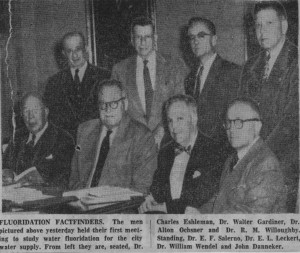This Month in History: The Truth and Community Water Fluoridation
We learned from childhood that if you give a mouse a cookie heÔÇÖs going to want a glass of milk. It is lesser known, however, whether an increase in milk consumption in the general rodent population is directly caused by rampant cookie consumption among mice. Correlation does not necessarily indicate causation.?á A similar logical fallacy comes from one member of the Church of the Flying Spaghetti Monster who claims that there exists ÔÇ£a statistically significant inverse relationship between pirates and global temperature;ÔÇØ therefore, according to him, more piracy will decrease global temperature and the number of natural disasters. These examples, though silly, illustrate the importance of scientific research in drawing causation in an uncontrolled environment and in distinguishing between folklore, coincidence, and the truth.
One such truth-seeking project involves public health and is the source of long-standing controversyÔÇöthe issue: community water fluoridation (CWF). Beginning in 1954 in New Orleans, a committee of health professionals convened to address CWF. The committee consisted of several area doctors including LSU Medical CenterÔÇÖs Dr. Russell Holman, who served as Professor and Head of the Pathology Department from 1946 until his death in 1960. An article from the New Orleans Item in 1955 describes the committee as divided and unsure with the exception of Dr. Holman, who planted his support firmly on the side of fluoridation. A final decision was made in 1957 to veto CWF due to a need for further study.
Articles within the past few years on nola.com address CWF in New Orleans following Hurricane Katrina as being a lack of supply. Now it appears that fluoride has been returned to our water. A 2010 Sewage and Water Board of New Orleans report defines fluoridation as a way ÔÇ£to prevent tooth decay.ÔÇØ Later in the same report, fluoride is defined as a ÔÇ£contaminantÔÇØ: its presence on average .8ppm on the East Bank and .81ppm on the West Bank. Likely sources are listed as ÔÇ£erosion of natural deposits; water additive which promotes strong teeth; discharge from fertilizer and aluminum factories.ÔÇØ
Though the addition of fluoride to the nation’s drinking water has become common practice, the matter of its efficacy is still unresolved. In weighing the risks and benefits of CWF, the exact nature of correlation between improvements and harm to the publicÔÇÖs dental health remains unclear. Proponents of community health attempt to account for socioeconomic factors, access to dental care, pyorrhea and periodontal concerns in children and adults, as well as fluorosis, a cosmetic issue caused by over-fluoridation.
The CDC has called water fluoridation ÔÇ£one of the 10 great public health achievements of the 20th century,ÔÇØ and in 2010, the center’s statistics show the percentage of the U.S. population receiving fluoridated water at 66.2%. Perhaps we ought to take a cue from the Church of the Flying Spaghetti Monster: take to sea, forget dental care, and go marauding!
Glimpse of the Past is an ongoing project to promote the Louisiana Digital Library effort. This Month in History will present for your reading pleasure a closer look into a newspaper clipping of note from our Digital Collections and articles relating to the LSU Medical School.?á

 myLSUHSC
myLSUHSC